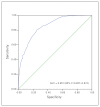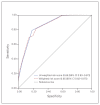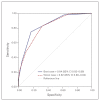The TRAAGIC score: early predictors of inpatient mortality in adult trauma patients
- PMID: 31967443
- PMCID: PMC7828935
- DOI: 10.1503/cjs.016318
The TRAAGIC score: early predictors of inpatient mortality in adult trauma patients
Abstract
Background: Scoring systems are important in prognostication and decision-making in the management of trauma patients. However, they often include an extensive list of factors not easily recalled by clinicians on admission. Additionally, multivariable analyses examining predictors of mortality in these patients is lacking. This study aimed to develop and validate a mortality prediction score for adult trauma inpatients. The intention was to create a scoring tool that could be easily remembered and implemented by clinicians.
Methods: This is a retrospective analysis of 5175 adult trauma patients treated at a level 1 trauma centre in Hamilton, Ontario, from 2002 to 2013. For derivation of the score, logistic regression was applied to data collected from 2002 to 2006 to identify potential predictors. Variables with p ≤ 0.10 identified from univariable analysis were entered in the multivariable logistic regression. Statistical significance was set at a value of 0.05. The prediction performance of the score was then assessed and validated on data for trauma patients treated from 2007 to 2013. The discrimination ability and calibration of the validation model were assessed. Frequencies, odds ratios with 95% confidence intervals (CIs) and C-statistics were reported.
Results: The TRAAGIC prediction score (transfusion, age, airway, hyperglycemia, international normalized ratio, creatinine) showed a C-index of 0.85 (95% CI 0.83–0.87) in the derivation cohort. The TRAAGIC score had high discrimination and good calibration when applied to the validation cohort.
Conclusion: The TRAAGIC score is an easily remembered and straightforward toolthat can reasonably predict inpatient mortality for adult trauma patients.
Contexte: Les systèmes de classification sont importants pour le pronostic et le processus décisionnel relatifs à la prise en charge des patients de traumatologie. Par contre, ces systèmes incluent souvent une longue liste de facteurs dont les cliniciens peuvent difficilement se rappeler quand un patient est admis. De plus, on déplore l’absence d’analyses multivariées sur les prédicteurs de mortalité chez ces patients. La présente étude visait à concevoir et valider un score de prédiction de la mortalité pour les polytraumatisés adultes hospitalisés. L’intention était de créer pour les médecins un outil de classification facile à retenir et simple à utiliser.
Méthodes: Il s’agit d’une analyse rétrospective de 5175 polytraumatisés adultes traités dans un centre de traumatologie de niveau 1 de Hamilton, en Ontario, de 2002 à 2013. Le score est dérivé de l’analyse de régression logistique appliquée aux données recueillies de 2002 à 2006 pour dégager les prédicteurs potentiels. Les variables identifiées à partir d’analyses univariées dont p ≤ 0,10 ont été incluses dans l’analyse de régression logistique multivariée. La portée statistique a été fixée à 0,05. Le rendement prédictif du score a alors été évalué et validé pour les polytraumatisés traités de 2007 à 2013. On a évalué le pouvoir discriminant et l’étalonnage du modèle de validation, et on a fait état des fréquences, des rapports des cotes avec intervalles de confiance (IC) de 95 % et de la statistique C.
Résultats: Le score de prédiction TRAAGIC (transfusion, âge, voies aériennes, hyperglycémie, ratio international normalisé, créatinine) a produit un indice de concordance de 0,85 (IC de 95 % 0,83–0,87) dans la cohorte de dérivation. Le score TRAAGIC s’est révélé doté d’un important pouvoir discriminant et d’un bon étalonnage lorsqu’on l’a appliqué à la cohorte de validation.
Conclusion: Le score TRAAGIC est un outil facile à retenir et simple à utiliser qui permet de prédire raisonnablement le risque de mortalité chez les polytraumatisés adultes hospitalisés.
© 2020 Joule Inc. or its licensors
Conflict of interest statement
None declared.
Figures



References
-
- Chawda MN, Hildebrand F, Pape HC, et al. Predicting outcome after multiple trauma: Which scoring system? Injury. 2004;35:347–58. - PubMed
-
- Hameed SM, Schuurman N, Razek T, et al. Access to trauma systems in Canada. J Trauma. 2010;69:1350–61. - PubMed
-
- Champion HR, Sacco WJ, Hannan DS, et al. Assessment of injury severity: the triage index. Crit Care Med. 1980;8:201–8. - PubMed
-
- MacKenzie EJ, Rivara FP, Jurkovich GJ, et al. A national evaluation of the effect of trauma-center care on mortality. N Engl J Med. 2006;354:366–78. - PubMed
Publication types
MeSH terms
Substances
LinkOut - more resources
Full Text Sources
Medical
